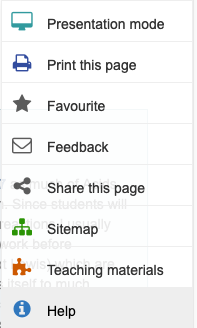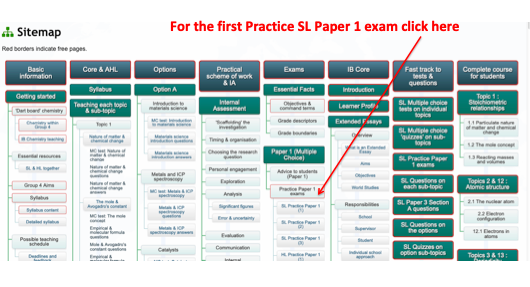How to navigate the site
This page gives a simple guide to help you find your way around the site to locate any page you want or to find any page that contains a particular word, part word or phrase using the search facility. Once you grasp the three different ways of navigating you will be able to explore the site fully to see for yourself the wealth of information, ideas and resources it contains.
Navigating the site
There are essentially three main ways to navigate your way around the site which contains nearly nine hundred pages. Once you have mastered the basics, then simply explore the site yourself to see the quality of exactly what it does contains.
You can see an introduction to what the site contains and how to navigate your way around either from the 9 minute video below or from the breakdown underneath.
1. Using the main headings
The main headings on the home page such as Core & AHL, Options, Exams etc. are self-explanatory.
Putting your cursor on one of them will bring a drop down menu. For example under Core & AHL you will find it contains six sub-headings. If you put the cursor on any one of these that has a right arrow (indicating that it has children) it will open up to show you the all the headings underneath, e.g. Teaching each topic & sub-topic will bring up the sub-headings associated with this topic.

If you then click on one of these, e.g. Topics 8 & 18 it will bring up the page itself.

This particular page contains an introduction to Core Topic 8 and AHL Topic 18: Acids and bases. On the left you can see a breakdown of all the sub-headings under Core & AHL and the headings under the chosen sub-heading Teaching each topic and sub-topic. You can see in bold the page that is open and the children pages attached to it. These eight children pages are the separate sub-topics under Topics 8 and 18. Clicking on any one of them will open the page, e.g. pH scale.

Each sub-topic page under this main heading contains the same layout with the time for teaching the sub-topic, Pause for thought, Nature of Science, Learning outcomes, teaching tips, suggestions for practical work, useful vocabulary, gallery of teaching slides and suggested resources etc. etc.
You can again see on the left that there are three children associated with this page. In fact all the sub-topics in the syllabus have the same three children attached to them, a ten-question multiple choice quiz, short-answer questions and the worked answers to the multiple choice questions.
You will notice a list of icons on the right of each page. If you open these up by moving the cursor onto the list you will see that they can be used for a variety of different functions.

2. Using the sitemap
The sitemap can be accessed from the drop down headings from the top heading Home on the home page or from any page using the function on the right of the page as shown in the image above
The sitemap shows every page on the site and you can click directly on any page you want e.g.

Note that the pages are colour-coded to show which pages are teacher only, which pages can be shared with students (mainly the quizzes, short-answer questions and multiple choice tests) and which pages students always have direct access to.
3. Using search
Just type in any word, part word or phrase in the search facility on the home page and it will bring up all the pages containing that word. For example, 'appendix' appears on five website pages. There are also 8 pages where the comments made by me or by subscribers include 'appendix'. You can even search your own name to find any comments you may have made in the past.


